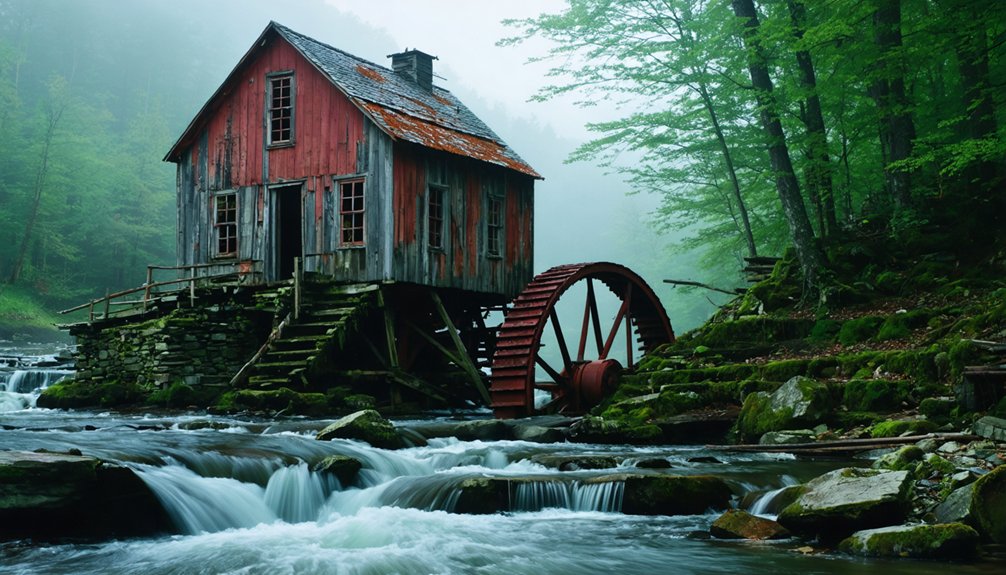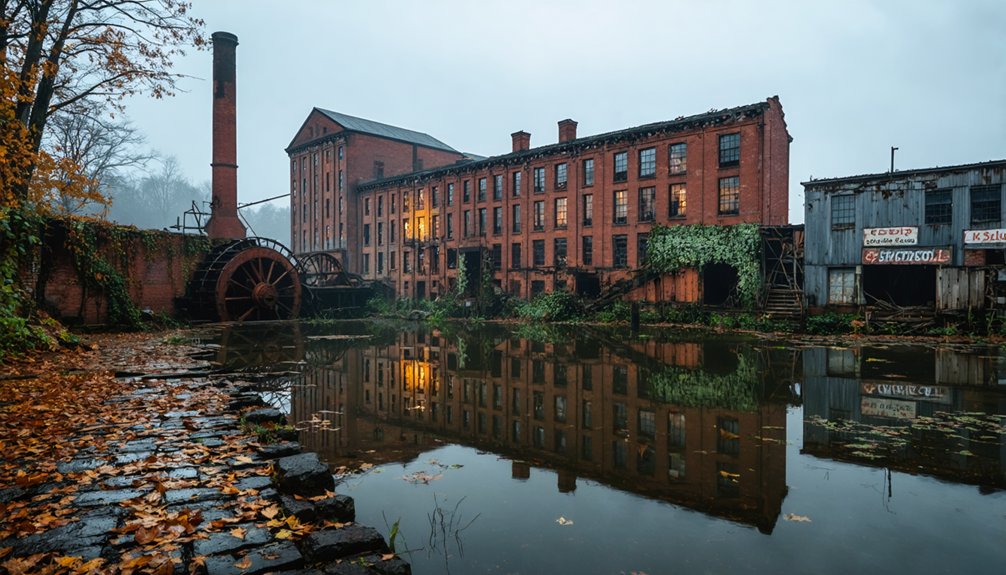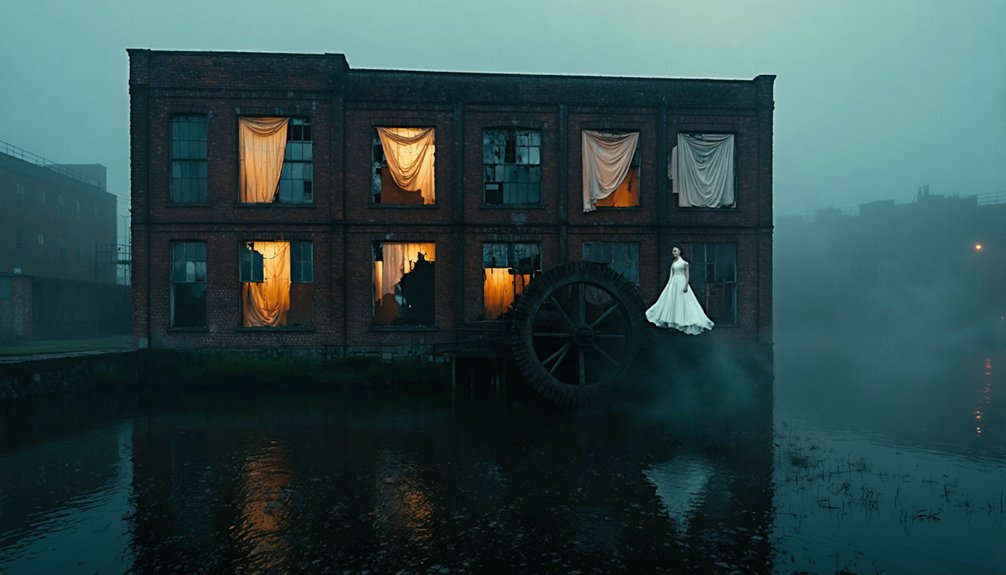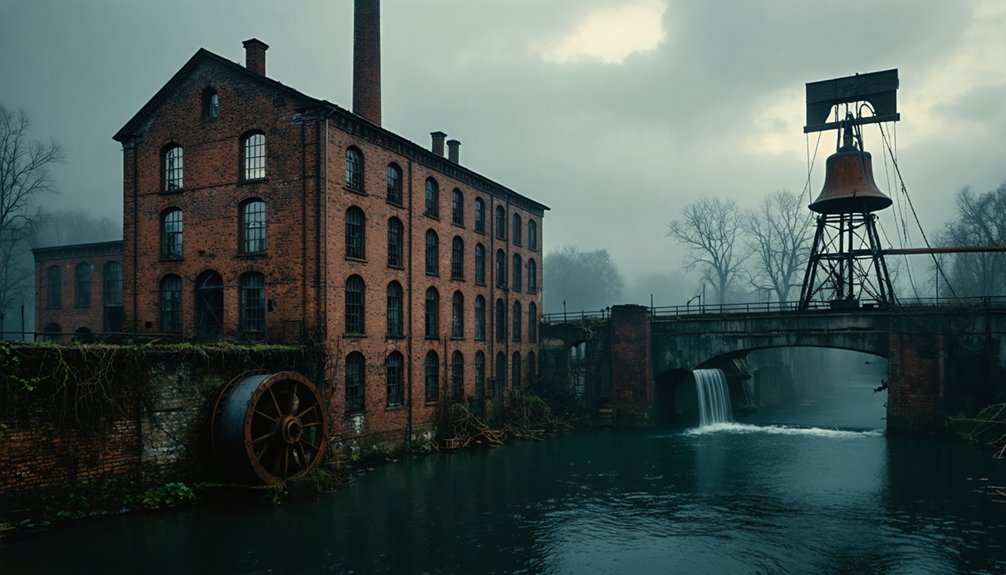Gallup Mills was once a thriving industrial settlement in Essex County, Vermont, powered by the area’s abundant waterways. You’ll find only stone foundations, crumbling cellar holes, and chimney remnants now, all slowly disappearing into the forest floor. The community declined after railroad competition and a devastating 1927 flood destroyed essential infrastructure. Local preservation efforts by Vermont historical societies continue documenting this vanished community. The quiet ruins tell a compelling story of boom-and-bust in the Northeast Kingdom’s industrial past.
Key Takeaways
- Gallup Mills was an industrial settlement in Vermont’s Essex County that transformed from farming to a mill-centered economy before being abandoned.
- Reliant on water-powered mills for its economy, the community declined after the 1850 railroad brought competition from cheaper goods.
- A devastating flood in 1927 destroyed critical infrastructure, accelerating the town’s abandonment.
- Today, only weathered stone foundations, crumbling cellar holes, and chimney remnants remain visible through the forest floor.
- Preservation efforts include archaeological surveys, historical documentation, and maintaining trails through the ruins.
The Origins of Gallup Mills: Vermont’s Forgotten Industrial Center

While many Vermonters recognize the state’s industrial heritage in larger centers like Rutland and Middlebury, few remember Gallup Mills, a once-thriving industrial settlement nestled along the waterways of Victory in Essex County.
You’re looking at a prime example of how Vermont’s abundant water resources shaped early industrial innovation. Like many settlements that dotted Vermont’s landscape, Gallup Mills emerged when settlers recognized the potential of rushing waters to power their operations.
The community dynamics evolved as the settlement shifted from subsistence farming toward a cash economy. Mills weren’t just places of production—they formed the beating heart of the community. Early town meetings in Hartland were also held at William Gallup’s residence, indicating his prominence in local governance.
When you visit the remnants today, you’re walking through the foundation of a society that built itself around the promise of water power.
Water Power and the Mill Economy of Gallup Mills
Situated along the rushing streams of Essex County, Gallup Mills harnessed Vermont’s abundant water power to fuel its economic engine throughout the 19th century.
You’d have found massive water wheels converting river energy into mechanical force, powering sawmills and gristmills essential to the community’s survival. This approach reflected Vermont’s long tradition of utilizing mechanical energy from hydropower for essential industries.
Unlike today’s electrified world, Gallup Mills relied entirely on dam systems that captured flowing water to drive production. The mill employed dozens of local workers, becoming not just an industrial center but the community’s social heart.
This industrial heritage shaped settlement patterns as families built homes near this economic lifeline.
When electricity eventually reached Vermont, many mills like Gallup’s couldn’t compete with larger hydroelectric operations, marking the beginning of its decline toward the ghost town you can explore today. Similar to how Vernon hydroelectric facility began operation in 1909, rural electrification gradually replaced traditional water-wheel powered industries across New England.
Daily Life in a 19th Century Vermont Mill Community
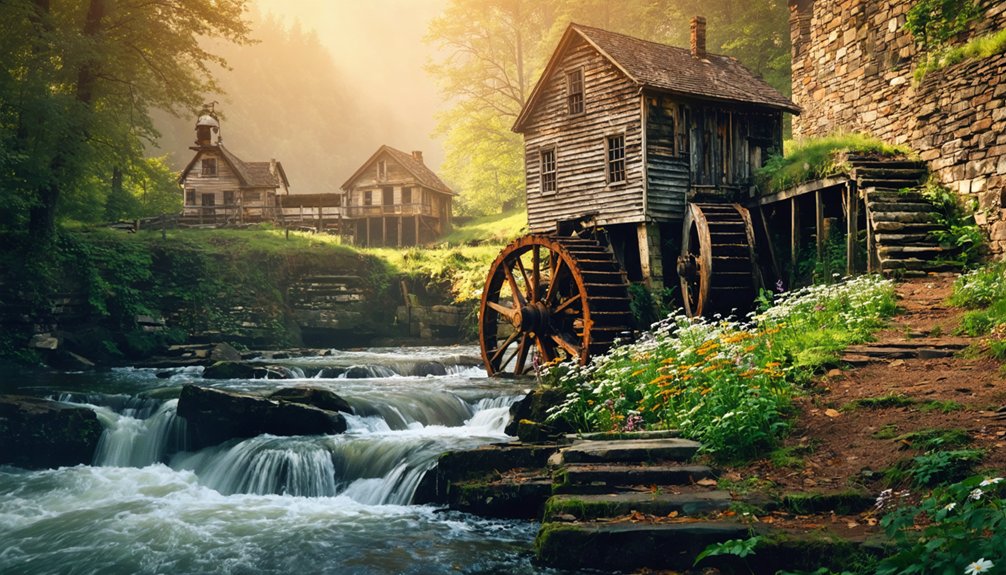
Life in Gallup Mills revolved entirely around the rhythms of mill work, with the morning whistle calling you to your station as the community stirred awake.
You’d labor 10-12 hours daily, six days a week, alongside neighbors in worker conditions that tested your endurance but forged tight bonds among families.
Your modest company home sat clustered with others along the river, while mill owners occupied larger residences on higher ground.
After work, you might attend church gatherings or seasonal community events like harvests and fairs.
Women managed households while often working mill shifts themselves.
Children split time between schooling, chores, and sometimes mill work.
When hardship struck, you’d rely on extended family and neighbors rather than formal welfare.
Mill workers sometimes participated in labor organizations that emerged across Vermont’s industrial centers as workers sought to address grievances about working conditions.
Despite the demanding schedule, this close-knit community created a shared identity centered on pride in the mill’s products.
Similar to Hartford Village, the economic and social structures of Gallup Mills were closely tied to the operation and success of its industrial enterprises.
The Decline: How Gallup Mills Became a Ghost Town
While Gallup Mills‘ residents once thrived alongside the humming looms and spinning wheels, the railroad’s arrival in 1850 brought cheaper manufactured goods from western states that local businesses couldn’t compete with.
The mill’s vulnerability became painfully evident when the devastating flood of 1927 destroyed critical infrastructure that the cash-strapped operation couldn’t afford to rebuild properly.
Unlike communities in southern Vermont that successfully diversified into tourism or specialized manufacturing, Gallup Mills remained tethered to its outdated single industry, sealing its fate as families gradually abandoned their generational homes. The mill workers faced conditions similar to other Vermont textile operations with low wages and long hours, further accelerating the town’s decline as laborers sought better opportunities elsewhere. The nearby mineral springs, particularly known for their healing properties, could have provided an alternative economic opportunity had they been developed with proper facilities like the planned hotel.
Transportation Revolution Impact
As Vermont’s transportation landscape evolved dramatically throughout the 20th century, Gallup Mills found itself increasingly isolated from the economic lifelines that once sustained it.
The transportation evolution that powered Vermont’s economy systematically bypassed smaller communities, leaving Gallup Mills without essential connections to larger markets.
You’d recognize these changes through:
- Abandonment of the river-based commerce system that initially supported the mill’s operations
- Centralization of railroad infrastructure away from peripheral settlements like Gallup Mills
- Loss of flexible bus services that once allowed unscheduled stops in small communities
- Shift from locally-managed transit companies to corporate conglomerates prioritizing profitable routes
Without adaptable transportation options, rural accessibility plummeted.
Gallup Mills, once vibrant with mill workers and commerce, gradually lost its economic purpose as residents struggled against mounting isolation in Vermont’s fragmented transportation network. This isolation worsened as companies like Vermont Transit Company disappeared, absorbed by larger corporations like Greyhound that focused on profitable interstate routes. The lack of coordinated transit systems left many rural communities with no public coverage, as Vermont’s twenty-six separate transportation providers concentrated services in more populated centers.
Economic Diversification Elsewhere
Throughout New England’s evolving economic landscape, many communities successfully pivoted toward new industries while Gallup Mills stagnated and ultimately collapsed.
You’ll find stark contrasts in towns that embraced economic resilience. While Gallup Mills faded, nearby communities transformed vacant factories into artisanal workshops, tech hubs, and tourism destinations. These towns invested in workforce development, attracting young entrepreneurs when manufacturing jobs disappeared.
Rural revitalization efforts succeeded elsewhere through community-led initiatives promoting local food systems and agritourism. Some former mill towns capitalized on heritage tourism, converting industrial buildings into museums or mixed-use developments. Vermont communities that once relied on wool production demonstrated remarkable adaptability by transitioning to dairy farming when market conditions changed.
Others focused on attracting remote workers with affordable housing and improved infrastructure. Unlike Gallup Mills’ singular dependence on traditional industries, these communities diversified, creating resilient economies that could withstand market shifts and provide sustainable livelihoods for their residents.
Natural Disasters’ Role
Natural disasters sealed Gallup Mills’ fate where economic adaptation might’ve saved it. In 1898, catastrophic flooding washed away the railroad tracks—the town’s lifeline for tourism, supplies, and connection to the outside world. This infrastructure collapse created an insurmountable isolation that quickly strangled the once-promising settlement.
The flood impacts were devastating on multiple fronts:
- Complete destruction of railroad tracks, bridges, and trolley routes
- Immediate abandonment of the resort and related businesses
- Failed repair attempts due to lack of resources and interest
- Permanent isolation making resupply and rebuilding impossible
Without its essential transportation links, you’d have found Gallup Mills cut off and economically nonviable. Residents were forced to leave, seeking opportunities elsewhere, while the harsh environment and repeated flooding discouraged any investment in rebuilding the community.
What Remains Today: Exploring the Ruins and Landscape
Weathered stone foundations peek through the forest floor in Gallup Mills, revealing traces of Vermont’s industrial past. As you explore the valley, you’ll discover crumbling cellar holes and chimney remnants scattered among thick underbrush.
The stream that once powered bustling mills now flows quietly past collapsed wooden beams and mill foundations.
You’ll need hiking boots to navigate the unmarked trails winding through this remote site. Wildlife encounters are common—deer and foxes frequently appear among the ruins.
The stone bridge abutment and visible water channels offer glimpses of the town’s former ingenuity.
The site isn’t maintained for tourists, giving you freedom to discover on your own terms. Seasonal changes dramatically transform the landscape, with winter’s bare trees revealing ruins that summer’s foliage conceals.
Preserving the Memory: Historical Documentation and Cultural Impact

While forgotten by many, Gallup Mills lives on through dedicated documentation efforts across Vermont. The Vermont History Explorer and UVM’s Center for Rural Studies preserve critical records of this once-thriving community, demonstrating remarkable resilience despite its physical disappearance.
Your connection to this vanishing heritage is maintained through:
Our shared link to vanishing places endures through careful preservation of what remains in archives and landscape.
- The Gazetteer of Vermont Places, which officially recognizes Gallup Mills as part of Victory’s historical landscape
- Archaeological surveys mapping remaining foundations and structures
- Local historical societies preserving firsthand accounts from former residents
- State parks and historical trails providing interpretive access to settlement remains
Memory preservation isn’t merely academic—it’s essential for understanding the Northeast Kingdom’s industrial past.
When you explore these documentation efforts, you’re participating in keeping Gallup Mills’ community spirit alive despite its physical absence from today’s maps.
Frequently Asked Questions
Are There Any Paranormal Legends Associated With Gallup Mills?
No, you’ll find no haunted history or spectral sightings connected to this locale. Historical records and local sources don’t mention paranormal legends, unlike other Vermont ghost towns you’re free to explore.
Can Visitors Legally Access the Ghost Town Site Today?
Yes, you can legally access the site via Radar Road, though there are no formal access regulations. Mind your safety—the remote area lacks facilities and features challenging terrain.
What Happened to Families Who Lived There After Closure?
You’ll find families scattered throughout Vermont and beyond after the closure, with most relocating to nearby towns for work. Their family relocation permanently altered the region’s historical impact and community fabric.
Did Any Famous Historical Figures Visit Gallup Mills?
Ever wonder who walked those mill grounds? No famous visitors ever came to Gallup Mills. Despite its historical significance to locals, this small Vermont community’s remote location didn’t attract well-known historical figures.
Are There Efforts to Restore Any Structures at Gallup Mills?
Based on available records, you won’t find active restoration efforts or historical preservation projects at Gallup Mills. Most structures have deteriorated naturally, with no documented community initiatives working to rebuild these forgotten remnants.
References
- https://www.visitgallup.com/blog/carbon-citys-coal-mining-legacy/
- https://www.burlingtonfreepress.com/story/news/2018/10/29/history-space-tale-two-vt-ghost-towns/38202243/
- https://happyvermont.com/2014/10/23/glastenbury-ghost-town/
- https://www.onlyinyourstate.com/experiences/vermont/ghost-town-vt
- https://www.youtube.com/watch?v=Yy85eB_ZBh8
- https://ournewenglandlegends.com/the-mystery-of-glastenbury-mountain-vermont/
- https://obscurevermont.com/tag/northeast-kingdom/
- https://vermonthistoryexplorer.org/client_media/files/GreenMountaineer/wasourtownamilltown.pdf
- https://en.wikipedia.org/wiki/List_of_ghost_towns_in_Vermont
- https://www.uvm.edu/cals/crs/gazetteer-vermont-places
